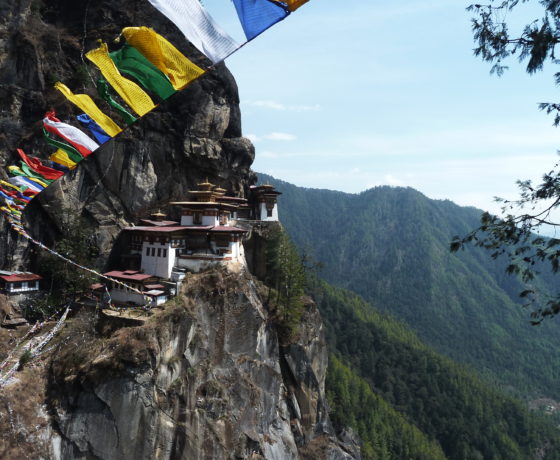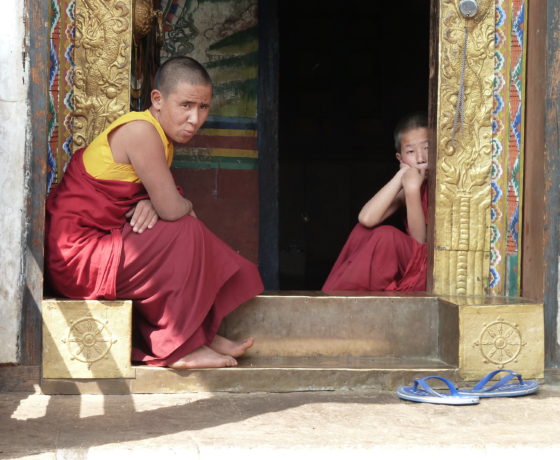Bhutan Sojourn
Tour Program
Imagine a travel destination where cyber cafés and mail carriers to remote places coexist; visit a place where you can feel safe and secure. Dream of a place where you can experience everything exotic. Only few places are left on Earth so undisturbed and Bhutan is certainly one of them; untouched, untainted and saturated with ancient culture and people. This mystical jewel of the Himalayas will not remain hidden forever. Visit now and discover it yourself before it is too late. Pick your travel date and we will organize this trip for you, or we can tailor-make one for you.
Following breakfast, you start with visit of Drukgyel Dzong. Once a fortress and Buddhist monastery, it was completely burnt down by fire in 1950’s and now full renovation work is going on to return it to its former glory. It is located in the upper part of the Paro District. The fort was built in 1649 to commemorate victory over an invasion from Tibet. Weather permitting; you can see the peak of goddess mountain Jomolhari. Drive back and stop to view Taktsang monastery in the distance. It is an amazing structure that appears to hang on a cliff. Continue to drive to Paro town where you visit the National Museum, Ta Dzong, built by the first Governor of Paro in 1649. Ta dzong protected the Rinpung Dzong from all the invasions by serving as a watchtower. The building design is unusual as it is round and is in the shape of a conch shell. This building was later converted into museum in 1968. The museum collection includes displays of spectacular thankas (religious scroll painting), textiles, ancient artifacts dating from 7th century onwards, beautiful Bhutanese stamps, a temple with the tree of wisdom depicting the history of Buddhism, a collection of animals, birds and butterflies and a collection of ancient urns that were used in cooking food for the armies. From here we drive to town for lunch. In the afternoon, take an easy walk crossing over the cantilever bridge to visit Rinpong Dzong, or “Fortress of the heap of Jewels” built in 1644. Now it houses offices of the Paro District administration as well as monks. The rest of the day is free to watch archery (a traditional Bhutanese sport) near Paro and wader through town. Overnight at the hotel. (B, L, D)
Following breakfast, start your journey to the capital Thimphu. The windy road passes through scenic distant mountains and valleys, agricultural farm land, deep gorges and surrounding villages. The road is all the way gentle downhill until we reach at the confluence of Paro and Thimphu rivers. After passing the confluence, the road ascends gently and the valley turns into a narrow gorge and then it widens from the village of Namseling. Thimphu city is visible from a distance. On arrival, check in to your hotel and relax until lunch time. After lunch, enjoy a relaxing day visiting local shops, centenary farmers market (Fri, Sat and Sun) and a craft bazaar. Overnight at the hotel. (B, L, D)
Following breakfast, we have a short drive north of the Thimphu valley to Dodina, and the dead-end of the road. Cross the cantilever/wooden bridge and enjoy a moderate hike for about an hour to Chari monastery through the temperate forest of oak, rhododendrons and other species of hard wood trees. The view from monastery below is very photogenic. Chari Monastery was built on the mountain in 1619 and is the upper education level monastic school. Even today there are monks/lamas who go for long retreats for 3 years, 3 months and 3 days. The small huts dotting the hill are for retreats. After visiting the temples, slowly descend down to the valley floor and drive back to the city for lunch. We might see archery taking place and visit the traditional handmade paper factory where we can see how the paper is made out of pulp of certain species of trees found in Bhutan. Overnight at the hotel. (B, L, D)
Following breakfast, enjoy full day of sightseeing. The first stop is at the Memorial Chorten. This is a most impressive stupa built in the memory of Bhutan’s third King by the order of Grand Queen mother in 1974. From here we go to Buddha Point where you see the tallest statue of Buddha Dordenma which is almost 170 feet tall with commending views of the Thimphu valley below. Next drive to Changangkha Lhakhang, the oldest temple in Thimphu dating back to 15th century. The next stop is to see see Takin, the national animal of Bhutan. From here you go to the Sangaygang view point with wonderful views of the Thimphu valley before visiting the Buddhist Nunnery where the nuns of all ages are practicing dharma and the National Library that holds a vast collection of ancient Buddhist texts, manuscripts and also modern academic books. The next stop is the National Institute for Zorig Chusum, which showcases thirteen traditional arts a crafts. The Royal Government of Bhutan sponsored and established this national institute in 1971 to preserve and promote culture and to contribute to the country’s economy through quality products and services. The final stop is at the Tashichho dzong. It is the biggest fort of Bhutan built and was built in 1648. It houses the secretariat building, the King’s throne room and other government offices. It is also the summer residence of the Chief Abbot. Overnight at the Hotel.
Following breakfast, drive to Punakha, the former capital of Bhutan until 1955 and still it serves as winter resident of the Chief Lama and houses both administrative offices and monk body of Punakha district. It was here that the first king of Bhutan was crowned in 1907 and the tradition still continues to this day. The road to Punakha is along scenic natural beauty through villages, temperate forests, with view of distant mountains and snow-capped Himalayas. Stop at Dochula Pass (3150m) marked by 108 stupas and thousands of colorful prayer flags hung around by people to bring good fortune to them and their family. Another new temple on top of a hill was recently built in honor of 4thDruk Gyelpo King Jigme Singye Wangchuk by Ashi Dorji Wangmo Wangchuk, the eldest queen Mother. With fine weather, you would be able to enjoy the panoramic view of the Himalayan range from the pass. Continue your drive through windy road to the sub-tropical valleys of Punakha and Wangdue. 20 minutes walking through rice terraces and farm houses takes you to the famous temple dedicated to Lama Drukpa Kuenley (crazy wisdom) called Chime Lhakhang or “temple of fertility”. It is situated on top of a knoll offering views of lush valleys of Punakha and Wangdue. This temple was built in the 15th century and is a pilgrimage site for barren couple. On your return, visit some of the farm houses, meet the farmers and have the feeling of daily lives of the village folks. Lunch will be served en route to the temple of fertility. Evening at leisure. You may wish to walk around on our own or simply relax in the hotel. (B, L, D)
Following breakfast, drive to Punakha and visit the most beautiful Dzong of Punakha situated in the confluence of Phochhu and Mochhu (male and female rivers). It looks like a giant ship with excellent wood work and detail of paintings. It is best example of Bhutanese art and architecture. It was here that the first King of Bhutan was crowned in 1907. It was capital of Bhutan until 1955 and later it was shifted to Thimphu. This dzong was built by Shabdrung Ngawang Namgyel in 1637. It still serves as winter resident of the chief lama of Bhutan and houses both administrative and religious center for Punakha district. After lunch, you have a short drive to enjoy the scenery of Wangdue valley and also visit the new Dzong built in the same architectural design after it was completely gutted by fire. Towards evening, return to your hotel. (B, L, D)
Following breakfast, drive back to Thimphu via the same road crossing over Dochula pass at an elevation of 3150m. You have a second opportunity to enjoy the panoramic views of the eastern Himalayas. Visit the Druk Wangyel Temple and also make circumambulation of 108 stupas and a short walk above in the surrounding nature, and when the weather is right, you have great views!. Lunch here. After lunch, drive to Thimphu and visit Dr. Tobgyal School, to meet with teachers and students and have a chance to talk with them. Overnight at the hotel. (B, L, D)
Following breakfast, drive to Paro and hike to Taktsang (Tiger’s Nest) monastery hanging on a cliff 800m above the valley. In the 8th century Guru Rimpoche flew here on the back of a tigress in one of his eight forms called Guru Dorje Drolo and meditated for 3 months in a cave, then converted the Paro valley into Buddhism. Later in the 17th century, the 4th temporal ruler of Bhutan Tenzin Rabgye built this present temple and named it Taktsang or Tiger’s lair (or nest) in the same spot where the Guru meditated. This temple is one of the most sacred and also a pilgrimage center for Buddhists from all over the world. It was completely burnt down in 1998 and re-built with help from the Bhutanese government, individual donors and financial supports from other nations. It takes 2 hours to walk to the closest view point and 1 hour to descend to the valley. Stop at café situated half way for refreshment. On your way back, you again stop at the café for lunch. After lunch, continue to walk down to the bottom of the valley where your vehicle is waiting and transfer to your hotel. Evening at leisure. Rest and prepare for your next day flight to next destination. (B, L)
Following early breakfast, transfer to Paro international airport for your journey home. (B)















